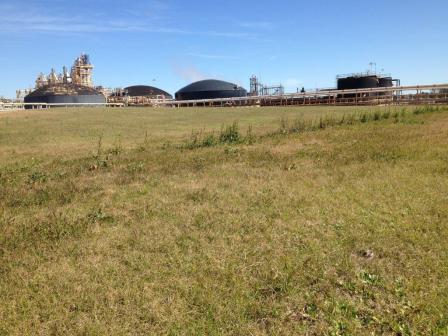Superfund Sites in Reuse in Alabama
If you are having trouble viewing the map in your browser, click the 'View larger map' link below
Capitol City Plume
 Capitol City PlumeThe Capitol City Plume Superfund site is located in Montgomery, Alabama. The site includes a large area of soil and groundwater contamination near the City of Montgomery’s public water supply well field. EPA proposed the site for listing on the Superfund program’s National Priorities List (NPL) in 2000. Primary site contaminants include chemicals commonly used in dry cleaning and machine part cleaning. The City is working closely with EPA to assess the groundwater contamination and develop a cleanup plan. Cleanup activities completed to date include removal of contaminated soil and groundwater monitoring. In 2010, the City planted 2 acres of poplar trees. These trees take up and break down contaminants from shallow groundwater. The City used EPA pilot funds to investigate reuse options and coordinate with EPA on the site’s future land use. The City is also in the process of integrating the site’s reuse plan with the City’s master plan for riverfront development. Riverfront redevelopment has already helped transform a mismatched assortment of commercial and open space uses into the downtown’s new Riverfront Amphitheater and Conference Complex. Downtown Montgomery remains open for business during the site’s groundwater cleanup. Land uses include retail districts, neighborhoods, parks, offices and industrial areas. The revitalization of Montgomery’s downtown is a major community priority. Referred to as the “heart of the city,” recent Montgomery redevelopment projects include the Montgomery Biscuits minor league baseball stadium, retail centers, downtown apartments and restaurants. Much of the site area above ground remains in continued use.
Capitol City PlumeThe Capitol City Plume Superfund site is located in Montgomery, Alabama. The site includes a large area of soil and groundwater contamination near the City of Montgomery’s public water supply well field. EPA proposed the site for listing on the Superfund program’s National Priorities List (NPL) in 2000. Primary site contaminants include chemicals commonly used in dry cleaning and machine part cleaning. The City is working closely with EPA to assess the groundwater contamination and develop a cleanup plan. Cleanup activities completed to date include removal of contaminated soil and groundwater monitoring. In 2010, the City planted 2 acres of poplar trees. These trees take up and break down contaminants from shallow groundwater. The City used EPA pilot funds to investigate reuse options and coordinate with EPA on the site’s future land use. The City is also in the process of integrating the site’s reuse plan with the City’s master plan for riverfront development. Riverfront redevelopment has already helped transform a mismatched assortment of commercial and open space uses into the downtown’s new Riverfront Amphitheater and Conference Complex. Downtown Montgomery remains open for business during the site’s groundwater cleanup. Land uses include retail districts, neighborhoods, parks, offices and industrial areas. The revitalization of Montgomery’s downtown is a major community priority. Referred to as the “heart of the city,” recent Montgomery redevelopment projects include the Montgomery Biscuits minor league baseball stadium, retail centers, downtown apartments and restaurants. Much of the site area above ground remains in continued use.
For more information:
Ciba-Geigy Corp. (McIntosh Plant)
The 1,500-acre Ciba-Geigy Corp. (McIntosh Plant) Superfund site is located in an industrial area two miles northeast of McIntosh, Alabama. Beginning in the early 1950s, the plant manufactured several different types of chemicals and products, including pesticides, herbicides, insecticides and plastics additives. Site operators improperly disposed of waste in several unlined pits and open landfills on the property. Prior to 1965, they also discharged wastewater into the Tombigbee River. A 1982 EPA site investigation found that site activities contaminated ground water, sediment, sludge, soil and surface water with various pesticides and chlorobenzene. EPA listed the site on the National Priorities List (NPL) in 1984 and initial cleanup actions began in 1985. Initial cleanup activities included the removal and treatment of contaminated ground and surface water and the closure of site surface impoundments and landfills. EPA selected a final cleanup plan in four separate Records of Decision (RODs) between 1989 and 1995. Cleanup activities included the continued extraction and treatment of contaminated ground water; excavation, treatment and disposal of contaminated sludge and soil; land and ground water use restrictions; construction of a below-ground barrier wall to divert ground water contamination; and the bioremediation of 10 acres of cypress swamps and a bottomland hardwood forest. EPA documented the completion of remedy construction in a 2000 closeout report. Ciba-Geigy Corporation stopped producing agricultural chemicals in 1999 and shut down herbicide and insecticide production in 2003. EPA designed the site’s cleanup plan to be compatible with the continued industrial use of the site. In 2009, BASF Corporation acquired the property. Today, BASF operates a chemical production facility at the site and leases a portion of the property to a nearby business for use as a parking lot.
For more information:
Olin Corp. (McIntosh Plant)
 Olin Corp. (McIntosh Plant)The 1,150-acre Olin Corp. (McIntosh Plant) Superfund site is located near the Tombigbee River in McIntosh, Alabama. Olin Corporation has operated a chemical manufacturing facility on site since 1952. Until 1974, the facility disposed of wastewaters into the Tombigbee River. The facility also disposed of solid waste in on-site landfills, ponds, plant areas and a drainage ditch. These activities resulted in groundwater contamination. EPA added the site to the Superfund program’s National Priorities List (NPL) in 1984. Cleanup activities included removing and treating groundwater. Workers also upgraded the landfill cap. Groundwater monitoring continues. Land and groundwater use restrictions in place. A fish consumption advisory is in effect for a portion of the Tombigbee River near the site. EPA issued an additional cleanup plan in 2014 to address remaining site contamination in the floodplain adjacent to the Tombigbee River. Olin Corporation continues to operate a chemical manufacturing facility on site.
Olin Corp. (McIntosh Plant)The 1,150-acre Olin Corp. (McIntosh Plant) Superfund site is located near the Tombigbee River in McIntosh, Alabama. Olin Corporation has operated a chemical manufacturing facility on site since 1952. Until 1974, the facility disposed of wastewaters into the Tombigbee River. The facility also disposed of solid waste in on-site landfills, ponds, plant areas and a drainage ditch. These activities resulted in groundwater contamination. EPA added the site to the Superfund program’s National Priorities List (NPL) in 1984. Cleanup activities included removing and treating groundwater. Workers also upgraded the landfill cap. Groundwater monitoring continues. Land and groundwater use restrictions in place. A fish consumption advisory is in effect for a portion of the Tombigbee River near the site. EPA issued an additional cleanup plan in 2014 to address remaining site contamination in the floodplain adjacent to the Tombigbee River. Olin Corporation continues to operate a chemical manufacturing facility on site.
For more information:
Perdido Ground Water Contamination
The 110-acre Perdido Ground Water Contamination Superfund site is located near the intersection of Highways 47 and 61 in Perdido, Alabama. In 1965, a train derailed, spilling benzene into the ditch along Highway 61. In 1981, the Alabama Department of Public Health documented reports of odors in residents’ drinking water wells. Alabama Department of Public Health sampling confirmed benzene contamination in ground water. Residents and businesses now use the public water system for drinking purposes. EPA added the site to the National Priorities List (NPL) in 1983. Cleanup activities included pumping and treating contaminated ground water. Residential and commercial use has continued along Highways 47 and 61.
For more information:
Stauffer Chemical Co. (Lemoyne Plant)
The 730-acre Stauffer Chemical Co. (LeMoyne Plant) Superfund site is located in Axis, Alabama. The Stauffer Chemical Company began operating a chemical manufacturing facility on site in the 1950s. From 1965 to 1979, waste disposal from Stauffer Chemical and another company on site resulted in contamination of groundwater, sediment, soil and fish in nearby Cold Creek Swamp. EPA added the site to the Superfund program’s National Priorities List (NPL) in 1984. Cleanup activities are ongoing and include groundwater treatment, capping of contamination and Cold Creek Swamp monitoring. The Alabama Department of Public Health placed a fish advisory on Cold Creek Swamp. Construction of a cap over part of the Cold Creek Swamp began in early 2015. Akzo Nobel currently owns the site property and manufactures chemicals at the site.
For more information:
Triana/Tennessee River
 Triana/Tennessee RiverThe Triana/Tennessee Superfund site is located in Huntsville, Alabama. From 1947 until 1970, the Olin Corporation operated a pesticide manufacturing plant on site. The company discharged wastewater into Huntsville Spring Branch. Waste handling practices at the site resulted in contamination of soil, sediment, surface water and fish tissue. The site includes an 11-mile stretch of the Huntsville Spring Branch and Indian Creek tributaries of the Tennessee River. EPA added the site to the Superfund program’s National Priorities List (NPL) in 1983. Cleanup activities included burying contaminated material, rerouting a stream channel, digging a new stream channel and constructing new water diversion structures. EPA, the Alabama Department of Environmental Management and Olin Corporation continue to monitor fish, surface water and sediment. The site is located completely within the Wheeler National Wildlife Refuge and the Redstone Arsenal. Created in 1938, the Refuge provides important habitat for migrating birds, as well as many other bird species. The Arsenal is home to the U.S. Army Aviation and Missile Command and other defense-related agencies.
Triana/Tennessee RiverThe Triana/Tennessee Superfund site is located in Huntsville, Alabama. From 1947 until 1970, the Olin Corporation operated a pesticide manufacturing plant on site. The company discharged wastewater into Huntsville Spring Branch. Waste handling practices at the site resulted in contamination of soil, sediment, surface water and fish tissue. The site includes an 11-mile stretch of the Huntsville Spring Branch and Indian Creek tributaries of the Tennessee River. EPA added the site to the Superfund program’s National Priorities List (NPL) in 1983. Cleanup activities included burying contaminated material, rerouting a stream channel, digging a new stream channel and constructing new water diversion structures. EPA, the Alabama Department of Environmental Management and Olin Corporation continue to monitor fish, surface water and sediment. The site is located completely within the Wheeler National Wildlife Refuge and the Redstone Arsenal. Created in 1938, the Refuge provides important habitat for migrating birds, as well as many other bird species. The Arsenal is home to the U.S. Army Aviation and Missile Command and other defense-related agencies.
For more information:
